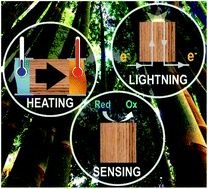Ultra-highly conductive hollow channels guided by a bamboo bio-template for electric and electrochemical devices†
Abstract
Fabrication of well-aligned arrays of microfluidic channels is very challenging using conventional microfabrication processes. On the other hand, nature is unique in creating complex hierarchical architectures. For instance, wood-derived materials present well-aligned microchannels that offer the possibility to add new functionalities to biological templates, such as high conductivity necessary for electric and electrochemical devices. However, one of the challenges is to address electrical properties without clogging cellulose-based channels. In this work, a new regioselective coating method is reported to prepare three-dimensional functional conductive structures using bamboo as a bio-template. Silver ink was flowed inside bamboo vascular bundles and excess of the material was removed to prepare ultra-highly conductive coatings that did not block its channels. The conductivity of the hollow channels was 9.3 (±4.0) × 105 S m−1, which is the highest value reported for cellulose-based ordered materials. Such remarkable feature enabled the fabrication of unprecedented electrical and electrochemical devices. For example, three-dimensional circuits, microfluidic heaters and fully integrated nanostructured carbon-based electrochemical cells were fabricated using bamboo with fast and low-cost prototyping processes. Moreover, the present work opens a plethora of possibilities to incorporate conductors, semi-conductors and insulating materials for the next generation of electric and electrochemical “bambootronic” bio-devices.

- This article is part of the themed collection: Celebrating Latin American Talent in Chemistry


 Please wait while we load your content...
Please wait while we load your content...